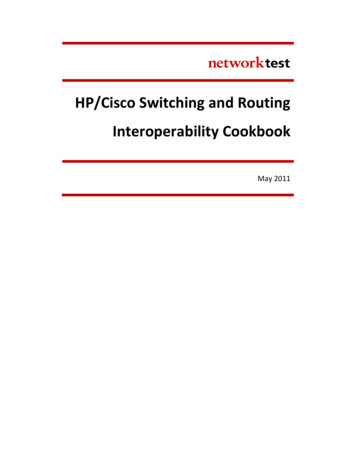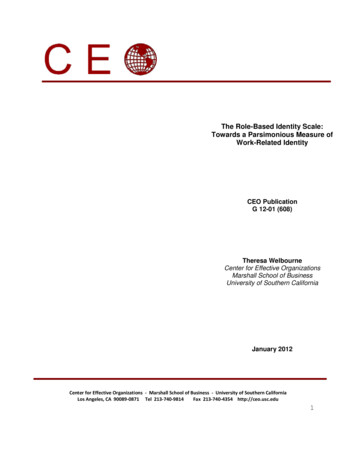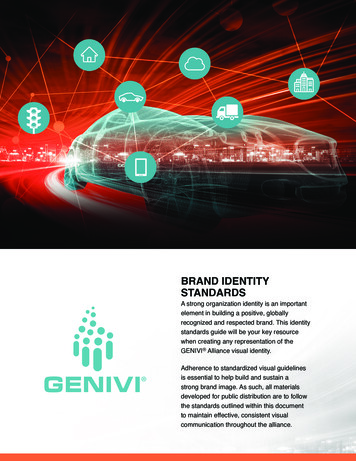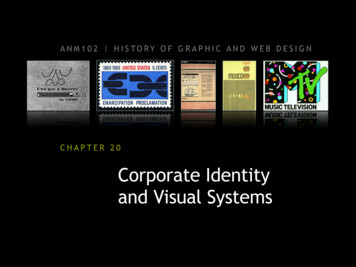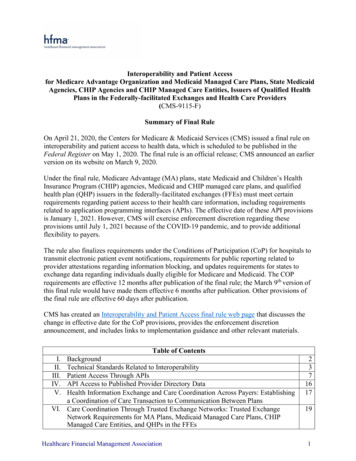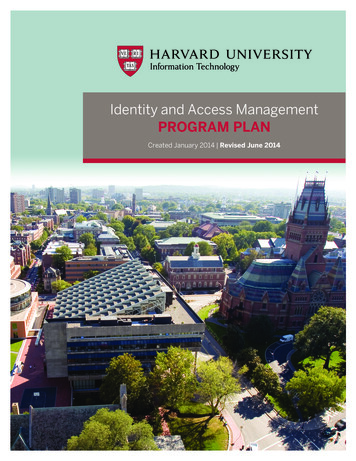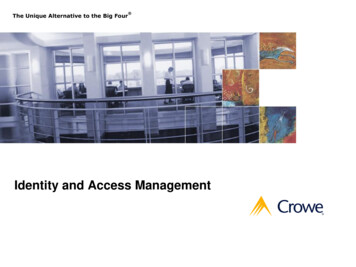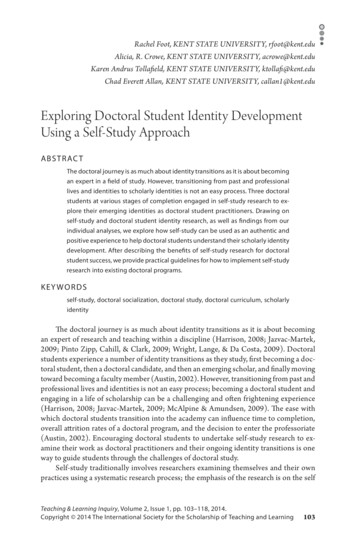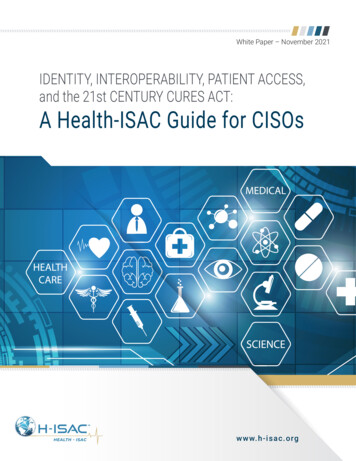
Transcription
White Paper – November 2021IDENTITY, INTEROPERABILITY, PATIENT ACCESS,and the 21st CENTURY CURES ACT:A Health-ISAC Guide for CISOsw w w. h - i sa c . o rg
SCOPE STATEMENTIDENTITY AND INTEROPERABILITYAn identity-centric approach to enabling secure and easy access to patient dataThe modernization of health care over the past decade has been pushed along by the digitization of healthinformation and records into Electronic Health Record (“EHR”) systems and Electronic Health Information(“EHI”). While this digitization has been transformational, the full value of digital health care cannot beunleashed without making these records interoperable and easily shareable – enabling patients to havegreater access to their own health information and where it flows to. In the United States for example, newfederal regulations tied to the implementation of the 21st Century Cures Act now require firms across thehealth market to enable interoperability of health data though the creation of new APIs designed to facilitateinformation sharing.These new interoperability mandates pose significant challenges, not the least of which is ensuring that newsystems deployed to enable information sharing do not create new security concerns. Digital identity is frontand center in these new interoperability architectures, given the importance of ensuring that only the rightpeople can access sensitive EHI.This paper – the fourth installment in Health-ISAC’s ongoing series focused on helping CISOs implement anidentity-centric approach to cybersecurity1 – will help CISOs understand how an identity-centric approach tosecuring and enabling access to EHI will allow health organizations to minimize risks involved in complying withthe 21st Century Cures Act. While this paper focuses on the new U.S. regulations, the concepts addressed init apply to any health organization looking to enable broader access to and exchange of EHI. Health-ISAC maylook to address a more comprehensive global view of laws, rules and regulations in a future paper.KEY TAKEAWAYS1. While APIs are the “door” to enabling interoperability of EHI between health organizations, strongidentity solutions are the “key” that keeps EHI secure.2. Looking beyond compliance and security, healthcare organizations have an opportunity as theydeploy more robust identity solutions to modernize the way they deliver healthcare, enabling newinnovation that can improve patient experiences. One way of accomplishing this may be throughissuing a high assurance digital credential to patients, or partnering with an organization that does.3. Additional government requirements for high assurance identity vetting and authentication in healthcare may be coming; prudent planning now can help future proof your organization to address newrequirements down the road.1. Health-ISAC’s first paper, Identity for the CISO Not Yet Paying Attention to Identity, explained why identity matters. We followed that with An H-ISAC Framework for CISOsto Manage Identity, outlining how CISOs can implement a comprehensive approach to identity-centric security that will protect against modern attacks and support keybusiness drivers. And our third paper was All About Authentication.2
INTRODUCTIONThe 21st Century Cures Act, meant to improve the discovery, development, and delivery of new treatmentsand cures, passed both houses of the U.S. Congress with strong bipartisan support and was signed into lawin December of 2016. A key problem the Act was designed to address was the need to catalyze a shift fromunconnected siloes of health data that stymied information sharing toward an ecosystem that enabled easy,interoperable, and secure exchanges of EHI. In essence, the law states that patients should have more controlof – and easier access to – their own health data, allowing them to access and share it wherever, whenever,and with whomever they want.To accomplish this, the Act set about standardizing the way “covered data” is to be exchanged so as to makehealth data accessible, while also removing barriers that prevent the flow of such data – all while keeping thedata secure and private, in a way that is efficient and cost effective.INTEROPERABILITY BASICSWho does Interoperability apply to? Health providers and health IT vendors –who must follow rules from the Office ofthe National Coordinator (ONC) for HealthIT in the Department of Health and HumanServices (HHS) enabling patients to accessEHI and download or transmit thoserecords via an API. Here, the focus is largelyon a new Fast Healthcare InteroperabilityResources (FHIR) “Patient Access API”developed by the non-profit standardsgroup Health Level 7 (HL7) that allowspatients to easily access data through athird party app of their choice.Interoperability definedThe 21st Century Cures Act defines interoperability as:“Health information technology that enables thesecure exchange of electronic health informationwith, and use of electronic health information from,other health information technology without specialeffort on the part of the user, allowing for completeaccess, exchange, and use of all electronicallyaccessible health information for authorized useunder applicable state or federal law” 2 Insurers – who must follow rules from the Center for Medicare and Medicaid Services (CMS) toimplement APIs that enable “health plan to health plan” data exchange, such as letting patientsaccess and transfer certain claims and clinical data, as well as pending and active prior authorizationdecisions.3 Here, the focus is largely on new “Payer to Payer Data Exchange APIs” and “ProviderDirectory APIs.”The regulations focus heavily on the concept of “Information Blocking” – defined as “business,technical, and organizational practices that prevent or materially discourage the access, exchangeor use of EHI when an Actor knows, or should know, that these practices are likely to interfere withaccess, exchange, or use of EHI.“2. 45 C.F.R. § 170.404(a)(1).3. Note that the CMS regulations only apply to government-funded health plans, but in practice, many major insurers are implementing this functionality for all theircustomers.3
In simple terms: if a patient asks any of these organizations to share their health data, thatorganization must enable it. Denial of a request to share EHI is considered “information blocking,”and may result in fines and penalties.What might “interoperability” look like in practice?Let’s translate that block of 21st Century Cures Act text into a real-world example of interoperability. Asthe 21st Century Cures Act envisions it, an individual, Rebecca, accesses a single secure application onher smartphone and is instantly connected with healthcare providers, pharmacies, insurers, and more.She can quickly, easily, and securely navigate this app to check her latest test results, request prescriptionrefills, and even check in on accumulated fitness data – with secure exchange of her data enabled by APIs.Furthermore, Rebecca isn’t limited to healthcare organizations she has an existing relationship with; any newdoctors or organizations that Rebecca engages with can immediately be sent any necessary EHI via APIs ina format that is instantly recognizable and useable.WHY IDENTITY MATTERS TO INTEROPERABILITYTo deliver the scenario described above, each party will need to solve numerous privacy, security, andusability challenges rooted in identity. Most patients will access EHI through an API established by theirprovider or insurer. But in order to do so, it will be important for that health organization to address severalkey functions tied to identity:1Authentication and Access: When “John Smith” asks for his health records to be sentto a new doctor, how does an organization know with certainty it is actually John Smithmaking the request – and not someone posing as him looking to steal his health data?How is this data securely accessed and transmitted after authentication?2Authorization: If John Smith only wants to share part of his records, how can he do so ina way that simply and efficiently captures his consent?3Governance and Administration: Who creates John Smith’s digital identity in the firstplace? What controls are in place to govern how his credential can be used? Whathappens if something goes wrong?4Patient Matching: If the organization has 83 “John Smiths” in its records, how does itknow “which John Smith” is making the request? Patient matching errors have led tomedical errors for years now, and the potential for errors is now exacerbated as newchannels are created for EHI to be shared.These functions are all covered in the Health-ISAC Identity Framework depicted on the next page. As theFramework details, patients are one of four primary types of users of a health organization’s Identity andAccess Management (IAM) system.While the types of access and services patients may need has traditionally varied significantly from what ahealth care practitioner might require, those lines are starting to blur with the new regulations, given that apatient is now able to request digital access to health data that in many cases was previously only readilyavailable to their provider.4
An H-ISAC Framework for Managing IdentityGovernance and ing, removing,and omersTargetSystemsandResourcesIDENTITY DIRECTORIESInternal Users Third-Party Users t/Customer&LifecycleGranting andgoverningaccess– AUTHORIZATION –– AUTHENTICATION & ACCESS –1. Granting Privileges – Ensuringthat users are tightly governed inwhat they can access and do, inaccordance with their roles, rightsor responsibilities2. Managing Privileges – Howare permissions or delegationsgranted or revoked?3. Review of Privileges – Ensuringusers’ rights are appropriate asroles or responsibilities change1. Device Authentication – Whatdevice is someone seeking to login from – and is it managed?2. Human Authentication – Are userswho they claim to be?3. Analytics – Are credentials beingused the way you’d expect themto be?4. Privileged Access Mangagement– Implementing additionalcontrols for privileged usersaccessing the most sensitiveassetsManaging privilegeescalationrequests3Managingpolicies andprocedures4ApplicationsFilesStorageSitesAudit ofidentityeventsAPIsBeyond the Framework, there are other security issues related to identity that are important to solve when itcomes to interoperability, including: Delegation: How can John Smith access and authorize use of EHI on behalf of someone he cares for,such as a child or an elderly relative? How can he choose to delegate those privileges to someone whocares for him? And how can he choose how long those delegated privileges should last? API Level Security: Given that FHIR APIs will be publicly available, how can an organization implement adynamic approach to secure them after the authorization to use is granted?The most effective way of mitigating the risk that these issues pose to organizations is through theimplementation of a modern, robust, and secure identity infrastructure that can securely authenticate andauthorize users and incoming requests, enforce the appropriate consent requests, and tightly govern the useof identities. By design, this is exactly what the Health-ISAC framework is meant to achieve.5
Is MFA Required?While the new ONC and CMS rules do not explicitly mandate multi-factor authentication (MFA), thegovernment guidance points strongly to MFA. The ONC rules require Health IT developers and EHR vendors to tell the Department of Health andHuman Services (HHS) whether they support MFA and for what use cases. If they do not supportMFA, they should “explain why the Health IT Module does not support authentication, through multipleelements, of the user’s identity with the use of industry recognized standards.”4 The CMS rules note “Multifactor authentication represents a best practice for privacy and security inhealth care settings, and we note that an important benefit of the OAuth 2.0 standard HHS is finalizingis that it provides robust support for multifactor authentication. By requiring that payers subject to ourPatient Access API requirement use an API that is conformant with 45 CFR 170.215 (the ONC rules forEHRs), where HHS has finalized the SMART IG, we are supporting the use of multifactor authentication.”Between this new guidance and the fact that the HHS Office for Civil Rights (OCR) has previously finedhealth organizations for HIPAA violations tied to inadequate authentication, there are notable risks tohealth organizations that choose not to use MFA. Health-ISAC detailed how health organizations can bestapproach implementation of MFA in our last Health-ISAC Identity Series white paper, “All About Authentication”– including the importance of adopting phishing-resistant authentication that can block commonly-usedattacks to steal one-time passcodes.5But wait – there’s more! (Pending ONC Guidance & High Assurance Credentials)While most health organizations are focused today on the API requirements, draft guidance from ONCwould create additional government requirements for high assurance identity vetting and authentication.The draft Trusted Exchange Framework and Common Agreement (TEFCA) is focused on enabling moresecure exchange of EHI across health information networks (HINs).Identity and security play a prominent role in TEFCA’s requirements which specifically invoke the DigitalIdentity Guidelines (SP 800-63-3) published by the National Institute of Standards and Technology (NIST).6Per the latest draft, TEFCA would require that credentials being issued to enable a patient to access theirmedical information be identity proofed to a minimum of Identity Assurance Level 2 (IAL2) as defined byNIST.7 And it would require that not just patients but other individuals be authenticated at a minimum ofAuthenticator Assurance Level 2 (AAL2), as defined by NIST. It would also require participants to supportfederation at what NIST defines as Federation Assurance Level 2 (FAL2).Note that TEFCA is a voluntary framework, but as a government-published guideline, it is likely to be highlyinfluential once finalized. This is another reason that health CISOs should be planning for ways to issuehigh assurance credentials to patients.4.5.6.7.See authentication and § 170.315 (d)(13) Multi-factor /publications/detail/sp/800-63/3/finalSection 6.2.4, 7.9 and 8.9 of 2019-04/FINALTEFCAQTF41719508version.pdf. Note that ONC has indicated final TEFCAguidance is expected to be published in early 2022.6
HOW CISOS SHOULD LOOK TO IMPLEMENT ANIDENTITY-CENTRIC APPROACH TO INTEROPERABILITYNow that we’ve established what interoperability is, the reason why healthcare organizations need to adoptit, and how identity ties interoperability into the Health-ISAC’s framework, let’s breakdown how to go aboutimplementing it.ComplianceAs we’ve noted, compliance with the requirements of the 21st Century Cures Act is mandatory, andthe pending guidance under TEFCA is both unfinalized and optional. As organizations look to becomecompliant with the Cures Act they will be well-served to not take an approach that fulfills the bare minimumneeded to achieve compliance.A minimalist approach not only represents a lost opportunity to make the most of the investment in timeand resources that will be required to carry out this update, but it is also likely to result in a suboptimalimplementation that creates needless friction for patients and may introduce new security risks.Furthermore, while the exact nature of the next round of guidance, as illustrated by initiatives like TEFCA, isnot completely clear, it is to be expected that it will go above and beyond the Cures Act.As painful as a single round of significant investment to achieve Cures Act compliance may be, embracinga serious overhaul with implementation rooted in secure identityinfrastructure now could save you from having to go through this processtwice. More future-ready infrastructure will deliver improved cybersecurityperformance and patient interaction.ImplementationBecause the FHIR and SMART standards are ultimately rooted in OAuthand OpenID Connect, insurers, providers, and other health stakeholders willlikely find that federation of their identity infrastructure with other healthcareapplications is the best option to attaining secure interoperability.In this instance, identity is what will enable healthcare organizations to go beyond compliancedriven investment and allow them to seek real strategic advantages. This is because robust identityinfrastructure can: Help organizations launch new health apps and services faster and more securely Enable organizations to more easily integrate with other providers and partners Streamline work needed to allow for the secure exchange of EHI with other parties – and make it easierto leverage that EHI for analytics that can drive additional insights into care and deliver better healthoutcomes Simplify consent capture and management involving the release of EHI, as well as cutting off access toEHI through an API when consent is revoked Empower patients to have more control over their health data and their health care experiences Provide improved protection against potential security breaches – especially when phishing resistantMFA is used, per our recommendations in our previous paper All About Authentication: A Health-ISACGuide for CISOs.7
CONCLUSIONIdentity is a journey. As the healthcare industry focuses on digital adoption, identity will continue to play afoundational role. Whether your implementation of a modern identity system is driven by regulatory andcompliance requirements, security and privacy concerns, or a desire to improve customer experience, a wellarchitected, robust digital identity solution can address all of these drivers.WHAT’S NEXT?This paper represents the fourth installment in a Health-ISAC series designed to introduce CISOs to an Identitycentric approach to cybersecurity. The first paper outlined why an Identity-centric approach was needed, thesecond outlined Health-ISAC’s framework for managing identity, and the third examined a key aspect of thatframework; authentication. This installment, focused on the patient access aspects of the framework, outlineshow the framework and an identity-centric approach is not only directly applicable to meeting new healthcareregulations in the U.S., but how it can provide significant security and business advantages.More In-depthAnalysisHelp ShapeFuture PapersMembers should expectsubsequent releases toprovide in-depth analysisand guidance on many ofthe issues and technologiesintroduced in these papers,as well as topical issuesrelated to identity-centriccybersecurity.As we go through thisprocess together, yourinput will be vital in craftingthese follow-on papers.Furthermore, we willprovide a means for HealthISAC members to submitfeedback as we considerfuture papers, so that wemay ensure that this seriesthoroughly examines theaspects that need furtherclarification or elaboration.Feedback on this white paperand suggestions for futuretopics are encouraged andwelcome. Please email us atcontact@h-isac.org.8Helping Organizationsof All Sizesand Maturity LevelsHealth-ISAC is committedto improving the entirehealthcare cybersecurityecosystem; this series willassist organizations of anysize and any cybersecuritymaturity in adapting theirdefense models to addressthe current threat landscapeand become more secure.
KEY TERMS AND ACRONYMSElectronic Health Information (EHI) – Also known as “electronic Protected Health Information(ePHI)”, this term is defined as information that a patient would have the right to request a copy ofunder the HIPAA Privacy Rule.Electronic Health Records (EHR) - a digital version of a patient’s paper records that providesreal-time, patient-centered records, and makes information available instantly and securely toauthorized users.Health Information Exchange (HIE) - An individual or entity that determines, controls, or has thediscretion to administer any requirement, policy, or agreement that permits, enables, or requires theuse of any technology or services for access, exchange, or use of EHI.Health Information Network (HIN) – A term Interchangeable with HIE (see above definition)Center for Medicare and Medicaid Services (CMS) – The Federal agency that administers theMedicare program, the federal portion of the Medicaid program and State Children's HealthInsurance Program, the Health Insurance Marketplace, and related quality assurance activities.Part of the Department of Health and Human Services (HHS).Office of the National Coordinator for Health Information and Technology (ONC) – Also partof HHS, ONC is charged with coordination of nationwide efforts to implement and use the mostadvanced health information technology and enable the electronic exchange of health information.Office for Civil Rights (OCR) – The part of HHS that enforces HIPAA violations. OCR ensuresthat individuals receiving services from HHS-conducted or funded programs are not subject tounlawful discrimination, that individuals and entities can exercise their conscience rights andreligious freedom, and that individuals can access and trust the privacy and security of their healthinformation.Fast Healthcare Interoperability Resources (FHIR) - A standard application programming interface(API) used to represent and exchange health information. FHIR is used to help developers buildapplications and support interoperability in healthcare.Health Level 7 (HL7) - A non-profit standards development organization dedicated to providinga comprehensive framework and related standards for the exchange, integration, sharing, andretrieval of electronic health information. HL7 houses the FHIR standard.US Core Data for Interoperability (USCDI) - A standardized set of health data classes andconstituent data elements for nationwide, interoperable health information exchange.9
ADDITIONAL RESOURCES21st Century Cures -114publ255.pdfCMS Interoperability and Patient Access Final ability-andONC Interoperability and Information Blocking Final certificationTrusted Exchange Framework and Common Agreement ntFeedback on this white paper and suggestionsfor future topics are encouraged and welcome.Please email us at contact@h-isac.orgw w w. h - i sa c . o rg10
the 21st Century Cures Act. While this paper focuses on the new U.S. regulations, the concepts addressed in it apply to any health organization looking to enable broader access to and exchange of EHI. Health-ISAC may look to address a more comprehensive global view of laws, rules and regulations in a future paper. IDENTITY AND INTEROPERABILITY 1.
